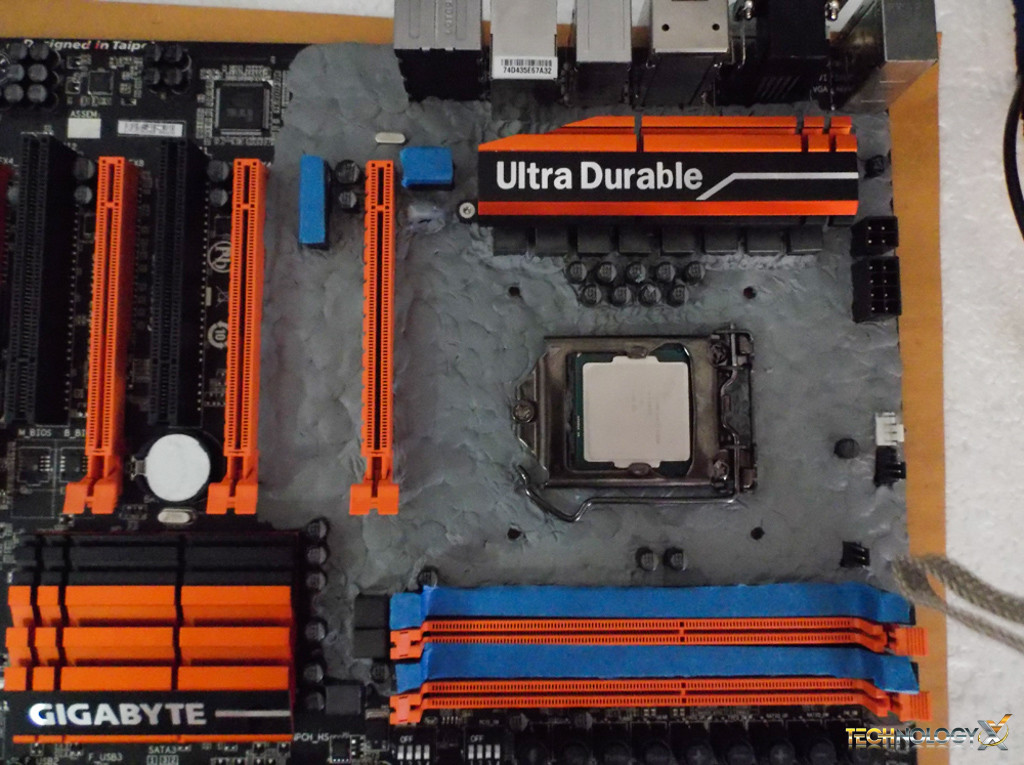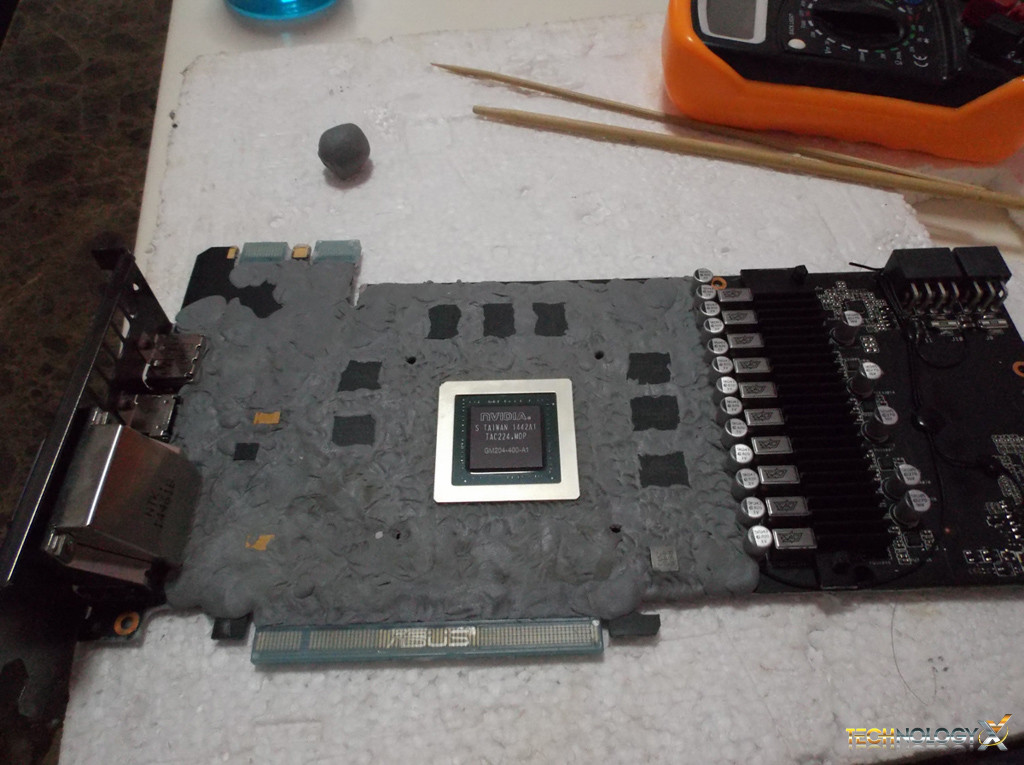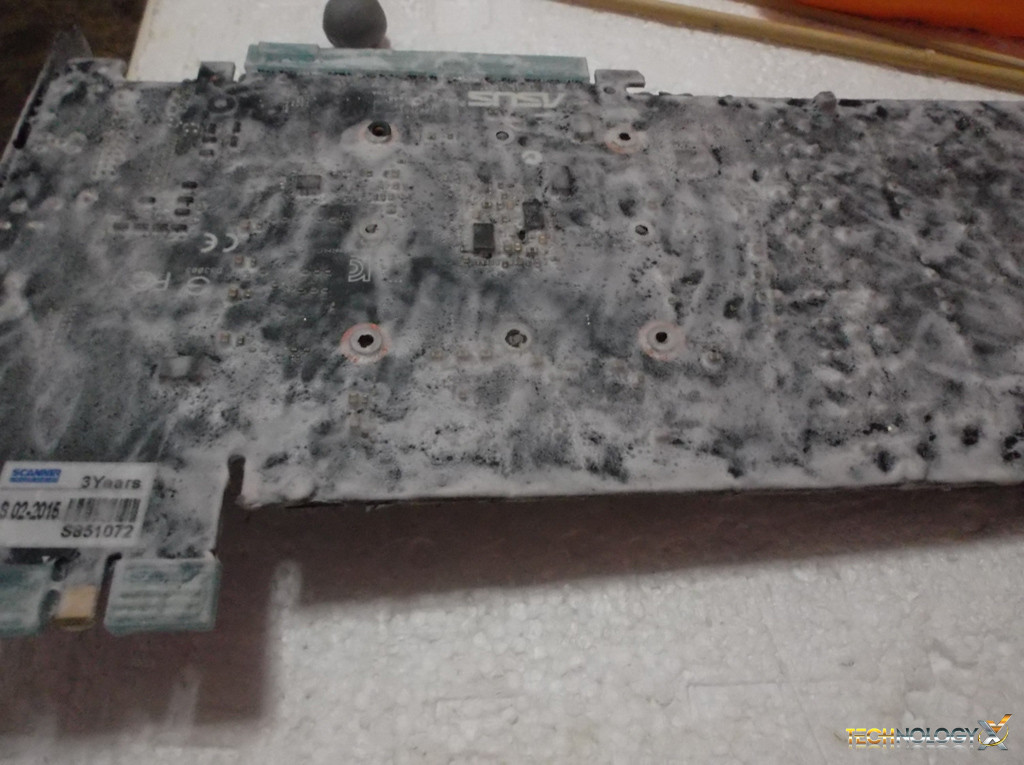A SIMPLE HOW TO ON INSULATING
As you can see in the following pictures we have used a kneadable art eraser to insulate the Board’s top side. Underneath the board we have used Vaseline to insulate, using a paint brush to spread the Vaseline over the socket half of the board and seal it by using a hairdryer. Other methods include conformal coating on both sides of the board, but on the topside can be tedious as you need to cover all slots plus CPU socket so they don’t get the coating on during spraying. Just think of spray paint as an example. Liquid Electrical Tape can also be used on both sides. We have also used blue painters tape to cover the unused RAM slots, the first PCIe slot and PEG connectors to protect those areas against condensation.
 Next you can push a length of paper towel into the gaps between the RAM slots and even wrap the VRM heatsink with paper towels to soak up any condensation as well as provide a seal in the area. It can be very tedious to get a good layer of protection with eraser in that area. A layer of Armaflex sheet comes in handy as well to lay your motherboard on top of.
Next you can push a length of paper towel into the gaps between the RAM slots and even wrap the VRM heatsink with paper towels to soak up any condensation as well as provide a seal in the area. It can be very tedious to get a good layer of protection with eraser in that area. A layer of Armaflex sheet comes in handy as well to lay your motherboard on top of.
GRAPHICS CARD INSULATION
Insulating your graphics card follows the same principles as your motherboard. This can be seen better by some pictures. Below is the front side:
On the back side we have used a spray on liquid electrical tape, although you can use the paint on on both sides, which is just as easy to apply a few coats, then let it dry for 24 hours.
One thing to note is most graphics cards require hard volt mods to be able to overclock to their potential on subzero cooling. Cards that do not require hard volt mods include the following:
- MSI Lightning series cards
- EVGA Kingpin edition cards
- Asus Matrix series cards
POT INSULATION
Pots can be run bare although to help with condensation issues that might arise from the pot sweating when warming up as an example. To do this you can use Armaflex tape and wrap your pot in that or a tube of close cell foam that is about a quarter inch thick, then wrap some of your paper towels around the pot for another layer of protection. This will soak up any condensation that may come from the pot as well as condensation from vapor. Another good practice is to place fans to blow vapor away from your system.
 Technology X Tomorrow's Technology Today!
Technology X Tomorrow's Technology Today!



Why don’t you just use conformal coat the insulate the board from moisture, that’s what it’s designed to do? We use Humiseal 1B31 at work for military boards. It glows blue under UV too so would look groovy at an event if you could get some black lights =P
Hi,
I have toyed with idea of using conformal coating and just need to get some. Thanks for giving me a product name. i will also look out for others and not much in conformal coating is available here in Thailand so will have to probably import it. Not a problem tho and your right it does work and would look nice with some UV lights 🙂
Thanks for the article! Very well written. It’s classified as hazardous material so transporting usually has an extra cost along with certain rules. Check into that before ordering =) Generally we buy from https://www.ellsworth.com/products/conformal-coatings/
or the like, but I think you can even get it on Amazon.
Thank you for comments, I will certainly look out for that product as well. Much appreciated your kind words too 🙂
Hello,
great guide
I have my own method i use, it is a combination of common insulation methods.
Required Materials:
Vaseline
Eraser
Liquid Electrical Tape
Electrical Tape
Neoprene Insulation
Armaflex.
paper towel
Painters tape
Sorry i have no photos so i will half to describe it to the best of my abilities, if you have any questions just ask.
Step 1
Remove everything and anything that can be screwed off of the board. This includes the heat sinks and cpu security bracket.
We are going to be covering the top of the board in a thick layer of Liquid Electrical Tape, this will make a water proof seal. if the liquid tape gets under a pci slot then it is stuck there. The board will still work but your chance of RMA has greatly diminished lest something bad happen. To prevent this we are going to take the eraser and roll it into long strips, place the thin strips in any tight space where the liquid tape won’t be able to be removed. This means sealing off the bottom of PCI Lanes, The edge of the cpu socket, Mosfets in the power delivery. Use your common sense.
Step 2
Now that all your tight spaces are sealed off take your LET and start painting it across the board. Your probably going to want to put a cpu in the socket to prevent it from dripping into the socket and ruining your board.You want to paint a thick layer, remeber there is no such thing as to much tape. The more tape you us the easier it is to remove. Generally you shouldn’t be able to see the colour of the pcb through the tape. (pro tip, well the paint is what you should poke through any mounting holes, it will save you alot of time)
Step 3
Rub Vaseline into the PCI and DIMM slots that you are using, its ok it can be removed completely with a blow-dryer. Apply Vaseline to the cpu socket. Just carefully place a small amount of Vaseline in the centre of the socket and then hit it with a blow dryer to spread it around the socket. Keep doing this until you have gotten decent coverage in the socket.
Step 4
put everything back on the motherboard,
Step 5 (optional)
You can now apply a layer of LET to the back of the board, there isn’t anything that needs to be sealed with eraser, this only takes a few minuets and creates extra protection but ins’t that necessary.
Step 6
Place the board on a sheet of Neoprene, this will seal the back of the board off completely and is why step five is not to important. sandwich the neoprene between backplate of your mounting system and the motherboard. Poke wholes for the screws so that the neoprene gets pressed into the board once you apply the pot.
Step 7
wrap your pot in a layer of painters tape and then wrap it in a thick layer of armaflex insulation tape.
From here you can follow Stuarts guide starting at page 4.
Sorry if it was unclear in anywaym, i did my best.
As me anything if you need
Thanks Sean,
Great layed out method you use, certainly solid 🙂